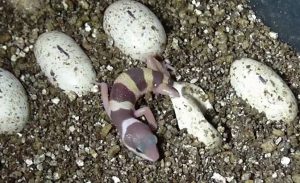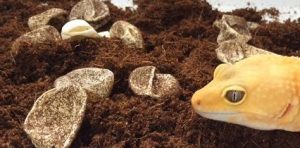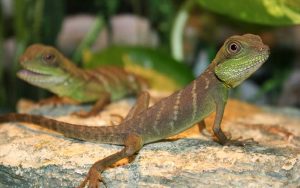Female geckos are able to lay eggs without a male, but the eggs produced are unfertilised. Therefore, they cannot produce babies on their own. Some reptiles, such as the Asian water dragon, can reproduce asexually, without a male.
Egg laying in geckos
Similar to birds, female geckos are able to produce eggs even without a male. However, the eggs they produce are unfertilised. This means the genetic information which would normally come from a male is not present, so a baby cannot develop inside the egg.
If a female gecko produces an egg in the absence of a male, there is little point trying to incubate it. The egg will simply start growing fungus, so you should remove any unfertilised eggs as soon as they are laid. However, if you do decide to breed geckos, and mate male and female, then the eggs produced will be fertilised and therefore can be incubated to produce young.

Breeding geckos
Female geckos have to be around a year old to be ready to start breeding. Interestingly, male geckos can breed from a much younger age. Most breeders wait until their female geckos are 2 years old to ensure healthy and successful offspring though.
One of the really unique aspects of gecko breeding is the incubation. You can control whether the eggs will develop into males or females by controlling the incubation temperature:
If the temperature is kept at about 25 degrees (celsius), a majority of females will be produced. At a higher temperature, around 30 degrees, mostly males will be produced. A temperature which is too high or too low can cause undeveloped eggs.

The eggs will take between one and a half to three months to develop. The exact length of the development will depend on the temperature chosen for incubation. An important factor is to make sure the temperature is constant during this time.
Unlike bird eggs which have hard calcium shells, gecko eggs look and feel more like soft leather, and can expand slightly as the gecko babies grow. Because of their soft shells, another factor of successful breeding is maintaining a high level of humidity. A damp substrate should surround the eggs. This will prevent the shells from drying.

Can any reptiles have babies without a male?
An interesting example of reptiles reproducing without a male is the Asian water dragon. Zookeepers discovered this ability as recently as 2015. The zookeepers decided to incubate some eggs produced by a water dragon without a male. They were surprised to see some eggs successfully develop. To check the genetic makeup of the offspring, the scientists compared DNA samples from the resulting baby lizards and the mother. The results showed that they were essentially clones, with identical DNA.

This is from a process called asexual reproduction: producing babies with only one parent. At the moment, we are aware of around 20 different species of reptiles that are able to reproduce this way.
Scientists think that when females cannot find partners, they use asexual reproduction so that they are still able to pass genes onto the next generation. This maintains the survival of the species.
Animal–Club provides animal parties or animal handling workshop where your will be able to see, learn and interact with the hamsters and other wonderful animals with the help of our presenters. Our mobile zoo has many friendly animals such as rabbits, tarantulas, geckos, vinegaroons and more that will be perfect for an animal party. We can also come over to your school for an animal school visit or arrange for an animal workshop with us where the children can learn about animals and have fun too.



